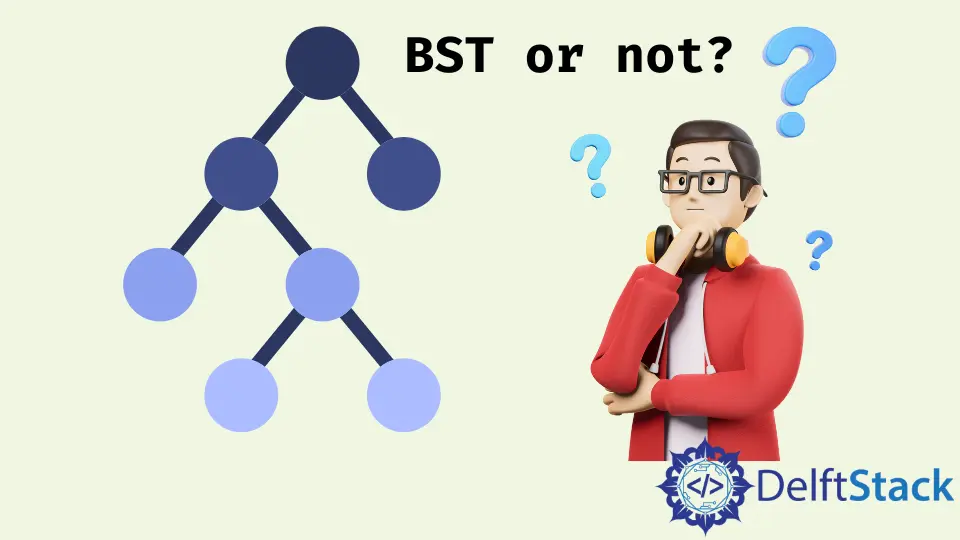二叉搜索树检查

二叉树是一种非线性数据结构。它被称为二叉树,因为每个节点最多有两个子节点。这些子节点被称为左子和右子。一个二叉树要想成为 BST,必须满足以下属性。
- 左侧子树的所有节点都比根节点小。
- 右侧子树中的所有节点都比根节点大。
- 左子树和右子树也必须是二元搜索树。
二叉树是否为二叉搜索树的检验算法
算法 1
在这种方法中,我们通过将每个节点视为其子树的根,来检查左子树是否包含任何大于根值的元素,以及右子树是否包含小于根值的元素。为了找到最大和最小元素,我们必须使用两个独立的函数 getMin() 和 getMax()。
getMin()
-
初始化
temp为root。 -
当
temp有一个left时,执行以下操作。- 设置
temp为temp->left,即向左移动找到最小的元素。
- 设置
-
返回
temp->val作为该子树的最小值。
getMax()
-
初始化
temp为root。 -
当
temp有一个right时,执行以下操作。- 设置
temp为temp->right,即向右移动找到最大的元素。
- 设置
-
返回
temp->val作为该子树的最大值。
isBST(root)
-
如果
root是NULL,返回true。 -
通过调用 getMax(root->left)在左边子树中找到最大元素
maxm。 -
通过调用 getMin(root->right)在右侧子树中查找最小元素
minm。 -
如果根元素小于
maxm或大于minm,返回 false。 -
通过调用
isBST(root->left)和isBST(root->right)递归检查所有节点。如果两个递归调用都返回 true,那么这棵树就是 BST,返回 true,否则返回 false。
上面的算法告诉我们一棵树是否是 BST,但速度极慢。函数 getMin() 和 getMax() 在最坏情况下的时间复杂度为 O(n),它们是为 n 节点调用的,使得总的时间复杂度为 O(n2)。
算法 2
该算法在前一种算法的基础上进行改进,不做重复计算。前一种方法对每个节点都调用 getMin() 和 getMax()。这个方法在上面的方法上做了改进,在我们遍历节点的时候,一直跟踪最小值和最大允许值。
isBST(root)
-
初始化两个变量
min为INT_MIN,max为INT_MAX。 -
调用
isBST(root,min,max)。
isBST(root, min, max)
-
如果
root是NULL,返回true。 -
如果
min>root->data,则违反 BST 属性,返回 false。 -
如果
max<root->data,则违反 BST 属性,返回 false。 -
通过调用
isBST(root->left, min, root->data-1)递归检查左子树(传递min和root->data - 1作为参数改变左子树中 BST 的有效范围),通过调用isBST(root->right, root->data+1, max)递归检查右子树(传递root->data + 1和max作为参数改变右子树中 BST 的有效范围)。 -
如果两个递归调用都返回
true,则树为 BST,返回true。
此算法的时间复杂度为 O(n),比前一种方法有很大的改进。
算法 3
这个算法避免了上面算法中使用 INT_MIN 和 INT_MAX,用两个指针 l 和 r 代替。
isBST(root)
-
初始化两个节点
l和r为NULL。 -
调用
isBST(root, l, r)。(重载函数调用)
isBST(root, l, r)
-
如果
root是NULL,返回true。 -
如果
l不是NULL并且l->data>=root->data,则违反 BST 属性,返回 false。 -
如果
r不是NULL并且r->data<=root->data,那么 BST 属性被违反,返回 false。 -
通过调用
isBST(root->left, left, root)(将 root 作为第三个参数传递,改变子树的最小值限制)和调用isBST(root->right, root, right)(将 root 作为第二个参数传递,改变子树的最大值限制)来递归检查左边的子树。 -
如果两个递归调用都返回
true,则该树为 BST,返回true。
算法 4:
二叉搜索树的 inorder 遍历按排序顺序返回元素。我们可以利用这个特性来检查一棵二叉树是否为 BST。如果无序遍历中的所有元素都不是按升序排列,那么给定的树就不是二叉搜索树。
isBST(root)
-
将变量
prev初始化为INT_MIN。prev用于检查当前节点是否大于prev,从而按照排序顺序进行。 -
调用
isBST(root, prev)。(重载函数 Call)。
isBST(root,prev)
-
如果
root是NULL,返回true。 -
通过
isBST(root->left, prev)递归检查左子树。如果返回false,则返回 false。 -
如果
root->data<=prev,违反了升序,返回 false。 -
将
prev->data更新为root->data。 -
通过
isBST(root->right, prev)递归检查右子树。如果返回false,则返回 false。 -
否则,返回 true。
检查二叉树是否为二叉搜索树的算法实现方法
算法 1
#include <iostream>
using namespace std;
class Node {
public:
int data;
Node *left, *right;
Node(int x) {
this->data = x;
this->left = this->right = NULL;
}
};
int getMin(Node* root) {
while (root->left) {
root = root->left;
}
return root->data;
}
int getMax(Node* root) {
while (root->right) {
root = root->right;
}
return root->data;
}
bool isBST(Node* root) {
if (root == NULL) return true;
if (root->left != NULL && getMax(root->left) > root->data) return false;
if (root->right != NULL && getMin(root->right) < root->data) return false;
if (!isBST(root->left) || !isBST(root->right)) return false;
return true;
}
int main() {
Node* root = new Node(6);
root->left = new Node(3);
root->right = new Node(9);
root->left->left = new Node(1);
root->left->right = new Node(5);
root->right->left = new Node(7);
root->right->right = new Node(11);
if (isBST(root)) {
cout << "This binary tree is a BST." << endl;
} else {
cout << "This binary tree is not a BST." << endl;
}
return 0;
}
算法 2
#include <iostream>
using namespace std;
class Node {
public:
int data;
Node *left, *right;
Node(int x) {
this->data = x;
this->left = this->right = NULL;
}
};
bool isBST(Node* root, int min, int max) {
if (root == NULL) return 1;
if (root->data < min || root->data > max) return 0;
return isBST(root->left, min, root->data - 1) &&
isBST(root->right, root->data + 1, max);
}
bool isBST(Node* root) { return isBST(root, INT_MIN, INT_MAX); }
int main() {
Node* root = new Node(6);
root->left = new Node(3);
root->right = new Node(9);
root->left->left = new Node(1);
root->left->right = new Node(5);
root->right->left = new Node(7);
root->right->right = new Node(11);
if (isBST(root)) {
cout << "This binary tree is a BST." << endl;
} else {
cout << "This binary tree is not a BST." << endl;
}
return 0;
}
算法 3
#include <iostream>
using namespace std;
class Node {
public:
int data;
Node *left, *right;
Node(int x) {
this->data = x;
this->left = this->right = NULL;
}
};
bool isBST(Node* root, Node* l, Node* r) {
if (root == NULL) return true;
if (l != NULL and root->data <= l->data) return false;
if (r != NULL and root->data >= r->data) return false;
return isBST(root->left, l, root) && isBST(root->right, root, r);
}
bool isBST(Node* root) {
Node* l = NULL;
Node* r = NULL;
return isBST(root, l, r);
}
int main() {
Node* root = new Node(6);
root->left = new Node(3);
root->right = new Node(9);
root->left->left = new Node(1);
root->left->right = new Node(5);
root->right->left = new Node(7);
root->right->right = new Node(11);
if (isBST(root)) {
cout << "This binary tree is a BST." << endl;
} else {
cout << "This binary tree is not a BST." << endl;
}
return 0;
}
算法 4
#include <iostream>
using namespace std;
class Node {
public:
int data;
Node *left, *right;
Node(int x) {
this->data = x;
this->left = this->right = NULL;
}
};
bool isBST(Node* root, int& prev) {
if (!root) return true;
if (!isBST(root->left, prev)) return false;
if (root->data <= prev) return false;
prev = root->data;
return isBST(root->right, prev);
}
bool isBST(Node* root) {
int prev = INT_MIN;
return isBST(root, prev);
}
int main() {
Node* root = new Node(6);
root->left = new Node(3);
root->right = new Node(9);
root->left->left = new Node(1);
root->left->right = new Node(5);
root->right->left = new Node(7);
root->right->right = new Node(11);
if (isBST(root)) {
cout << "This binary tree is a BST." << endl;
} else {
cout << "This binary tree is not a BST." << endl;
}
return 0;
}
复杂度分析
时间复杂度
- 平均情况
为了检查给定的二叉树是否是 BST,我们必须遍历所有 n 节点,因为一个不符合属性的节点将导致该树不是 BST。因此,时间复杂度是 [Big Theta]:O(n)。
- 最佳情况
最佳情况下的时间复杂度为 O(n)。它与平均情况下的时间复杂度相同。
- 最坏情况
最坏情况下的时间复杂度为 O(n)。它与最佳情况下的时间复杂度相同。
空间复杂度
由于递归调用所需的额外空间,该算法的空间复杂度为 O(n)。
Harshit Jindal has done his Bachelors in Computer Science Engineering(2021) from DTU. He has always been a problem solver and now turned that into his profession. Currently working at M365 Cloud Security team(Torus) on Cloud Security Services and Datacenter Buildout Automation.
LinkedIn